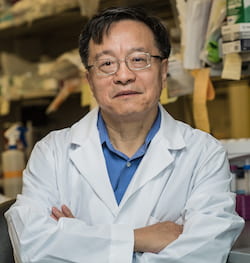HOUSTON – (Aug. 20, 2021) – Rice University faculty members led by bioengineer Gang Bao have been awarded a $4 million grant by the Cancer Prevention and Research Institute of Texas (CPRIT) to establish the Genetic Design and Engineering Center (GDEC).
Rice’s first CPRIT Core Facility will provide a one-stop shop for Houston’s Texas Medical Center, of which the university is a member, and other institutions that require custom DNA constructs but have neither the expertise nor the facilities to design and validate them.
Bao said Rice already has the expertise, and the grant will allow the facility to be established at the BioScience Research Collaborative (BRC). He expects space will be configured for the GDEC over the next few months while equipment is ordered and staff are hired.
Bao has recruited high-profile researchers to GDEC’s executive committee, including Rice bioengineers Jeffrey Tabor, Caleb Bashor and Isaac Hilton and bioscientist Caroline Ajo-Franklin, and Cassian Yee, a professor in the Department of Melanoma and Medical Oncology and director of solid tumor therapy at the University of Texas MD Anderson Cancer Center. Tabor and Bashor will serve as associate directors of the GDEC.
Their intention is to dramatically accelerate the pace, scale and impact of cancer research through access to state-of-the-art tools for the design, construction and optimization of the DNA constructs at the heart of developing innovative approaches to treat disease. DNA constructs are artificial segments of genetic code used to modify the properties of living cells and tissues.
“Many cutting-edge technologies like synthetic biology and genome engineering start with designing DNA constructs, and the design, testing and optimization require a core facility,” said Bao, chair of Rice’s Department of Bioengineering and a renowned researcher in biomolecular engineering who will direct the center.
“We can go to commercial entities for these services, but they’re usually costly and time-consuming, and cannot do a lot of the engineering we need as quickly as we need it,” he said. “We have a lot of projects here at Rice and in collaboration with TMC that having a core facility will make much easier.”
“This is what the many of the folks at TMC are excited about,” Bashor added. “They’re world-class when it comes to developing cancer therapies, but we excel at designing with DNA. The hope is that working with us will let them develop enhanced therapies at a faster rate.
“They can also leverage the understanding of how to design with DNA that folks like Jeff and I have developed in our labs,” he said. “That expertise that is often not present in a clinical or translational environment.”
“Pretty much any bioscience or bioengineering researcher who deals with cells or molecules may use this core at Rice,” Tabor said. “I think it will touch many and establish a lot of new links between Rice and the TMC.”
While many researchers are able to perform basic genome engineering through CRISPR/Cas9 and modern cloning, among other techniques, few are able to do so at the scale required for the most advanced types of cutting-edge biomedical research. The Rice team say GDEC will feature automated, high-throughput molecular cloning to enable transformative, large-scale experimental projects that would not be possible for individual labs.
Bao said the five-year grant supports not only equipment and personnel but also a seed-grant fund to enable new projects. He said there will be a fee-for-service component, as well as large collaborative projects that produce data that can be used to apply for additional grants.
He noted the presence of GDEC will also help recruit talented faculty for Rice’s synthetic biology initiative and its highly respected Systems, Synthetic Biology and Physical Biology program.
“The GDEC core is precisely the kind of initiative Rice envisioned when it built the BRC,” said Provost Reginald DesRoches. “This will firmly establish Rice as a hub for collaborators at the Texas Medical Center and beyond who need cutting-edge DNA design to address many challenges, especially defeating cancer.”
The award was one of two to Rice in the announcement this week, the other for $250,000 to Omid Veiseh, an assistant professor of bioengineering and CPRIT Scholar who joined the university in 2016, to support his research into cytokine factories for the treatment of mesothelioma.
The grants are among 62 awarded by CPRIT this week for more than $142 million. CPRIT noted the grants -- part of $2.9 billion already awarded by the taxpayer-funded institute -- will “expand access to clinical trials, incubate innovative cancer research, support the state’s emerging biotechnology industry, provided needed cancer screenings for underserved Texans and recruit outstanding cancer researchers.”
Bao is the Foyt Family Professor of Bioengineering and a professor of chemistry, mechanical engineering and materials science and nanoengineering. Bashor is an assistant professor of bioengineering and biosciences. Tabor is an associate professor of bioengineering. Hilton is an assistant professor of bioengineering and of biosciences. Ajo-Franklin is a professor of biosciences.
-30-
Follow Rice News and Media Relations via Twitter @RiceUNews.
Related materials:
Cancer Prevention and Research Institute of Texas: https://cprit.texas.gov
Rice Department of Bioengineering: https://bioengineering.rice.edu
Rice Department of BioSciences: https://biosciences.rice.edu
Images for download:
https://news-network.rice.edu/news/files/2021/08/0823_CPRIT-1-web.jpg
Rice University will establish a Cancer Prevention and Research Institute of Texas Core Facility, the Genetic Design and Engineering Center, to accelerate the design, construction and optimization of DNA constructs required by innovative approaches to treat disease. (Credit: Illustration by Olivia Flynn/Bashor Lab)
https://news-network.rice.edu/news/files/2021/08/0823_CPRIT-2-web.jpg
Rice University has been awarded a $4 million grant by the Cancer Prevention and Research Institute of Texas to establish the Genetic Design and Engineering Center. (Credit: Illustration by Olivia Flynn/Bashor Lab)
https://news-network.rice.edu/news/files/2021/08/0823_CPRIT-3-web.jpg
CAPTION: Gang Bao. (Credit: Jeff Fitlow/Rice University)
https://news-network.rice.edu/news/files/2021/08/0823_CPRIT-4-WEB.jpg
CAPTION: Jeffrey Tabor. (Credit: Tommy LaVergne/Rice University)
https://news-network.rice.edu/news/files/2021/08/0823_CPRIT-5-WEB.jpg
CAPTION: Caleb Bashor. (Credit: Jeff Fitlow/Rice University)
Located on a 300-acre forested campus in Houston, Rice University is consistently ranked among the nation’s top 20 universities by U.S. News & World Report. Rice has highly respected schools of Architecture, Business, Continuing Studies, Engineering, Humanities, Music, Natural Sciences and Social Sciences and is home to the Baker Institute for Public Policy. With 3,978 undergraduates and 3,192 graduate students, Rice’s undergraduate student-to-faculty ratio is just under 6-to-1. Its residential college system builds close-knit communities and lifelong friendships, just one reason why Rice is ranked No. 1 for lots of race/class interaction and No. 1 for quality of life by the Princeton Review. Rice is also rated as a best value among private universities by Kiplinger’s Personal Finance.










